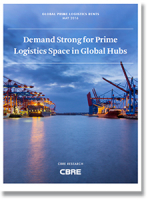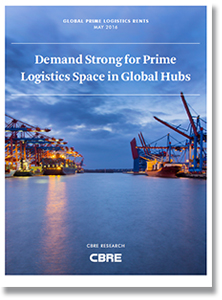Global Prime Logistics Rents - Demand Strong for Prime Logistics Space in Global Hubs
Despite a tumultuous global economic climate in 2015, prime logistics rents in global hub markets increased 2.8% year-over-year amid growing demand, driven principally by the growth of global supply chains and the expansion of consumption and production into new locations.
Over the past two decades, there has been a dramatic transformation in global trade and the industrial real estate market.
Today, industrial and logistics facilities are at the heart of rapidly evolving and expanding global supply chains and trade networks, serving as vital cogs in storing and moving billions of products across multimodal transportation networks worldwide at speeds once thought unimaginable.
At the same time, an ever-increasing share of retail sales - 7.5% today, up from 5.6% in early 2013, according to eMarketer - is taking place over the Internet, prompting both traditional retailers and e-commerce companies to reshape their supply chain organizations in key markets to fulfill online orders as quickly as possible.
Moreover, manufacturers and other industrial users are implementing more advanced “just-in-time” schemes to optimize inventory costs, and keeping customers happy, further stimulating demand for warehouse facilities.
However, not all industrial assets are equal. Advanced logistics users require modern big-box centers, which often have highly specialized features not often found in the typical warehouse.
These “prime” facilities typically are at least 100,000 sq. ft., or 10,000 sq. m., in size - in many cases, much larger than that - with clear ceiling heights of at least 26 feet, or 8 meters, to accommodate high-tech stacking racks and automated storage and retrieval systems, and have more loading docks - typically one for every 10,000 sq. ft., or 1,000 sq. m., of storage space - to ensure rapid and efficient throughput of goods in and out of the facility.
They are materially more expensive to build and to lease than lower-grade industrial facilities.
Location also matters more than ever. Sophisticated supply chain schemes require locations that are near or directly connected to transportation networks to take in goods, and, at the same time, need to be well-connected to - or even located within - major metros to deliver goods to the end user as quickly as possible.
Moreover, more firms are seeking smaller light industrial infill facilities to supplement their big boxes, stocking them with the most in-demand products and partnering with local courier services to gain a speed-to market advantage over competitors.
With this prime segment of the market becoming ever more important to the operations of logistics users - as well as to the bottom line of real estate owners and investors - CBRE Research has created this new semiannual report to enable readers to compare and understand prime rent values in 68 key logistics hubs around the world, ranking them from most expensive to least.
We segment out older, non-like facilities from the data set and report rent values on a dollar-per-sq.-ft. basis to ensure a like-for-like comparison across markets.
What’s Related



Favorites





